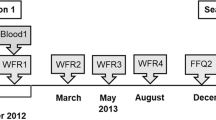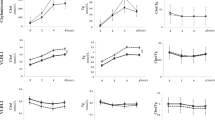Abstract
Objectives: To determine the fasting plasma concentrations of quercetin, hesperetin and naringenin in human subjects consuming their habitual diets, and diets either high or low in fruit and vegetables. To investigate whether plasma concentrations of flavanones can serve as biomarkers of their intake.
Design: This was a cross-over, strictly controlled dietary intervention consisting of a 2 week baseline period, and two 5 week dietary periods with a 3 week wash-out period in between. The low-vegetable diet contained few fruit and vegetables and no citrus fruit. The high-vegetable diet provided various fruits and vegetables daily including on average one glass of orange juice, one-half orange and one-half mandarin.
Subjects: Thirty-seven healthy females.
Results: The high-vegetable diet provided 132 mg of hesperetin and 29 mg of naringenin. The low-vegetable diet contained no flavanones. The mean plasma hesperetin concentration increased from 12.2 nmol/l after the low-vegetable diet to 325 nmol/l after the high-vegetable diet. The respective increase for naringenin was from <73.5 nmol/l for all subjects to a mean value of 112.9 nmol/l. The mean plasma quercetin concentration was 52 nmol/l after the baseline period, during which habitual diets were consumed, and it did not change significantly during the intervention. Interindividual variation in the plasma levels of hesperetin and naringenin was marked and, after the baseline and wash-out periods, and the low-vegetable diet, a majority of the samples had plasma flavanone levels below the limit of detection. After the high-vegetable diet, hesperetin and naringenin were detectable in 54 and 22% of all samples. Quercetin was detectable in nearly all samples after all study periods.
Conclusion: Hesperetin, naringenin and quercetin are bioavailable from the diet, but the plasma concentrations of hesperetin and naringenin are poor biomarkers of intake.
This is a preview of subscription content, access via your institution
Access options
Subscribe to this journal
Receive 12 print issues and online access
$259.00 per year
only $21.58 per issue
Buy this article
- Purchase on Springer Link
- Instant access to full article PDF
Prices may be subject to local taxes which are calculated during checkout

Similar content being viewed by others
References
Agullo G, Gamet-Payrastre L, Manenti S, Viala C, Remesy C, Chap H, Payrastre B . 1997 Relationship between flavonoid structure and inhibition of phosphatidylinositol 3-kinase: a comparison with tyrosine kinase and protein kinase C inhibition Biochem. Pharmac. 53: 1649–1657
Ameer B, Weintraub RA, Johnson JV, Yost RA, Rouseff RL . 1996 Flavanone absorption after naringin, hesperidin, and citrus administration Clin. Pharmacol. Ther. 60: 34–40
Bok SH, Lee SH, Park YB, Bae KH, Son KH, Jeong TS, Choi MS . 1999 Plasma and hepatic cholesterol and hepatic activities of 3-hydroxy-3-methyl-glutaryl-CoA reductase and acyl CoA: cholesterol transferase are lower in rats fed citrus peel extract or a mixture of citrus bioflavonoids J. Nutr. 129: 1182–1185
Borradaile NM, Carroll KK, Kurowska EM . 1999 Regulation of HepG2 cell apolipoprotein B metabolism by the citrus flavanones hesperetin and naringenin Lipids 34: 591–598
Caltagirone S, Ranelletti FO, Rinelli A, Maggiano N, Colasante A, Musiani P, Aiello FB, Piantelli M . 1997 Interaction with type II estrogen binding sites and antiproliferative activity of tamoxifen and quercetin in human non-small-cell lung cancer Am. J. Respir. Cell. Mol. Biol. 17: 51–59
Chopra M, Fitzsimons PEE, Strain JJT, Thurnham DI, Howard AN . 2000 Nonalcoholic red wine extract and quercetin inhibit LDL oxidation without affecting plasma antioxidant vitamin and carotenoid concentrations Clin. Chem. 46: 1162–1170
Conseil G, Baubichon-Cortay H, Dayan G, Jault JM, Barron D, Di Pietro A . 1998 Flavonoids: a class of modulators with bifunctional interactions at vicinal ATP- and steroid-binding sites on mouse P-glycoprotein Proc. Natl Acad. Sci. 95: 9831–9836
Dechaud H, Ravard C, Claustrat F, de la Perriere AB, Pugeat M . 1999 Xenoestrogen interaction with human sex hormone-binding globulin (hSHBG) Steroids 64: 328–334
De Stefani E, Boffetta P, Oreggia F, Brennan P, Ronco A, Deneo-Pellegrini H, Mendilaharsu M . 2000 Plant foods and risk of laryngeal cancer: a case-control study in Uruguay Int. J. Cancer 87: 129–132
De Vries JH, Hollman PC, Meyboom S, Buysman MNCP, Zock PL, van Staveren WA, Katan MB . 1998 Plasma concentrations and urinary excretion of the antioxidant flavonols quercetin and kaempferol as biomarkers for dietary intake Am. J. Clin. Nutr. 68: 60–65
Erlund I, Alfthan G, Siren H, Ariniemi K, Aro A . 1999 Validated method for the quantitation of quercetin from human plasma using HPLC with electrochemical detection J. Chromatogr. B. Biomed. Applic. 727: 179–189
Erlund I, Kosonen T, Alfthan G, Mäenpää J, Perttunen K, Kenraali J, Parantainen J, Aro A . 2000 Pharmacokinetics of quercetin from quercetin aglycone and rutin in healthy volunteers Eur. J. Clin. Pharmac. 56: 545–553
Erlund I, Meririnne E, Alfthan G, Aro A . 2001 Plasma kinetics and urinary excretion of the flavanones naringenin and hesperetin in humans after ingestion of orange juice and grapefruit juice J. Nutr. 131: 235–241
Fuhrman B, Aviram M . 2001 Flavonoids protect LDL from oxidation and attenuate atherosclerosis Curr. Opin Lipidol. 12: 41–48
Ghosal A, Satoh H, Thomas PE, Bush E, Moore D . 1996 Inhibition and kinetics of cytochrome P4503A activity in microsomes from rat, human, and cdna expressed human cytochrome P450 Drug Metab. Dispos. 24: 940–947
Hertog MGL, Hollman PCH, Venema DP . 1992 Optimization of a quantitative HPLC determination of potentially anticarcinogenic flavonoids in vegetables and fruits J. Agric. Food Chem. 40: 1591–1598
Hertog MGL, Feskens EJM, Hollman PCH, Katan MB, Kromhout D . 1993 Dietary antioxidant flavonoids and risk of coronary heart disease: the Zutphen Elderly Study Lancet 342: 1007–1011
Hertog MGL, Kromhout D, Aravanis C, Blackburn H, Buzina R, Fidanza F, Giampaoli S, Jansen A, Menotti A, Nedeljkovic S et al. 1995 Flavonoid intake and long-term risk of coronary heart disease and cancer in the Seven Countries Study Arch. Intern. Med. 155: 381–386
Hollman PC, van Trijp JM, Buysman MN, van der Gaag MS, Mengelers MJ, de Vries JH, Katan MB . 1997 Relative bioavailability of the antioxidant flavonoid quercetin from various foods in man FEBS Lett. 418: 152–156
Hollman PCH, Bijsman MNCP, van Gameren Y, Cnossen EP, de Vries JH, Katan MB . 1999 The sugar moiety is a major determinant of the absorption of dietary flavonoid glycosides in man Free Radic. Res. 31: 569–573
Huang Z, Fasco MJ, Kaminsky LS . 1997 Inhibition of estrone sulfatase in human liver microsomes by quercetin and other flavonoids J. Steroid Biochem. Mol. Biol. 63: 9–15
Hunter DS, Hodges LC, Vonier PM, Fuchs-Young R, Gottardis MM, Walker CL . 1999 Estrogen receptor activation via activation function 2 predicts agonism of xenoestrogens in normal and neoplastic cells of the uterine myometrium Cancer Res. 59: 3090–3099
Joshipura KJ, Ascherio A, Manson JE, Stampfer MJ, Rimm EB, Speizer FE, Hennekens CH, Spiegelman D, Willett WC . 1999 Fruit and vegetable intake in relation to risk of ischemic stroke JAMA 282: 1233–1239
Knekt P, Jarvinen R, Reunanen A, Maatela J . 1996 Flavonoid intake and coronary mortality in Finland: a cohort study Br. Med. J. 312: 478–481
Kuiper GG, Lemmen JG, Carlsson B, Corton JC, Safe SH, van der Saag PT, van der Burg B, Gustafsson JA . 1998 Interaction of estrogenic chemicals and phytoestrogens with estrogen receptor beta Endocrinology 139: 4252–4263
Kumpulainen JT, Lehtonen M, Mattila P . 1999 Trolox equivalent antioxidant capacity of average flavonoid intake in Finland In: Natural Antioxidants in Nutrition, Health and Disease ed. JT Kumpulainen & JT Salonen, pp 141–150 Cambridge: Royal Society of Chemistry
Kurowska EM, Spence JD, Jordan J, Wetmore S, Freeman DJ, Piche LA, Serratore P . 2000 HDL-cholesterol-raising effect of orange juice in subjects with hypercholesterolemia Am. J. Clin. Nutr. 72: 1095–1100
Mouly P, Gaydou EM, Auffray A . 1998 Simultaneous separation of flavanone glycosides and polymethoxylated flavones in citrus juices using liquid chromatography J. Chromatogr. A 800: 171–179
Pereira MA, Grubbs CJ, Barnes LH, Li H, Olson GR, Eto I, Juliana M, Whitaker LM, Kelloff GJ, Steele VE, Lubet RA . 1996 Effects of the phytochemicals, curcumin and quercetin, upon azoxymethane-induced colon cancer and 7, 12-dimethylbenz[a]anthracene-induced mammary cancer in rats Carcinogenesis 17: 1305–1311
Rouseff RL, Martin SM, Youtsey CO . 1987 Quantitative survey of narirutin, naringin, hesperidin and neohesperidin in Citrus J. Agric. Food Chem. 35: 1027–1030
Scalbert A, Williamson G . 2000 Dietary intake and bioavailability of polyphenols J. Nutr. 130: (Suppl 8): 2073S–2085S
Siess MH, Leclerc J, Canivenc-Lavier MC, Rat P, Suschetet M . 1995 Heterogenous effects of natural flavonoids on monooxygenase activities in human and rat liver microsomes Toxicol. Appl. Pharmac. 130: 73–78
Silaste ML, Rantala M, Sampi M, Alfthan G, Aro A, Kesaniemi YA . 2001 Polymorphisms of key enzymes in homocysteine metabolism affect diet responsiveness of plasma homocysteine in healthy women J. Nutr. 131: 2643–2647
So FV, Guthrie N, Chambers AF, Moussa M, Carroll KK . 1996 Inhibition of human breast cancer cell proliferation and delay of mammary tumorigenesis by flavonoids and citrus juices Nutr. Cancer 262: 167–181
Tanaka T, Makita H, Kawabata K, Mori H, Kakumoto M, Satoh K, Hara A, Sumida T, Tanaka T, Ogawa H . 1997 Chemoprevention of azoxymethane induced rat colon carcinogenesis by the naturally occurring flavonoids, diosmin and hesperidin Carcinogenesis 18: 957–965
van Acker FAA, Schouten O, Haenen GRMM, van der Vijgh WJF, Bast A . 2000 Flavonoids can replace α-tocopherol as an antioxidant FEBS Lett. 473: 145–148
Voorrips LE, Goldbohm RA, Verhoeven DT, van Poppel GA, Sturman F, Hermus RJ, van den Brandt PA . 2000 Vegetable and fruit consumption and lung cancer risk in the Netherlands Cohort Study on diet and cancer Cancer Causes Control 11: 101–115
Yang M, Tanaka T, Hirose Y, Deguchi T, Mori H, Kawada Y . 1997 Chemopreventive effects of diosmin and hesperidin on N-butyl-N-(4-hydroxybutyl)nitrosamine-induced urinary-bladder carcinogenesis in male ICR mice Int. J. Cancer 73: 719–724
Yochum L, Kushi LH, Meyer K, Folsom AR . 1999 Dietary flavonoid intake and risk of cardiovascular disease in postmenopausal women Am. J. Epidemiol. 149: 943–949
Acknowledgements
Juha-Matti Pihlava at the Agricultural Research Center of Finland, Jokioinen, Finland is thanked for helpful discussions concerning the flavonoid analyses of the diets. Eva Kammiovirta is thanked for excellent technical assistance.
Author information
Authors and Affiliations
Corresponding author
Rights and permissions
About this article
Cite this article
Erlund, I., Silaste, M., Alfthan, G. et al. Plasma concentrations of the flavonoids hesperetin, naringenin and quercetin in human subjects following their habitual diets, and diets high or low in fruit and vegetables. Eur J Clin Nutr 56, 891–898 (2002). https://doi.org/10.1038/sj.ejcn.1601409
Received:
Revised:
Accepted:
Published:
Issue Date:
DOI: https://doi.org/10.1038/sj.ejcn.1601409
Keywords
This article is cited by
-
A Minor Groove Binder with Significant Cytotoxicity on Human Lung Cancer Cells: The Potential of Hesperetin Functionalised Silver Nanoparticles
Journal of Fluorescence (2023)
-
Dietary factors associated with gastric cancer - a review
Translational Medicine Communications (2022)
-
Topoisomerase poisoning by the flavonoid nevadensin triggers DNA damage and apoptosis in human colon carcinoma HT29 cells
Archives of Toxicology (2021)
-
Pharmacokinetics of bioactive components after oral administration of Bojungikgi-tang in Korean subjects
Journal of Pharmaceutical Investigation (2020)
-
Comparative inhibitory potential of selected dietary bioactive polyphenols, phytosterols on CYP3A4 and CYP2D6 with fluorometric high-throughput screening
Journal of Food Science and Technology (2015)



